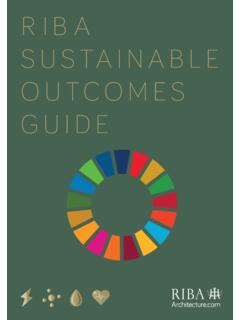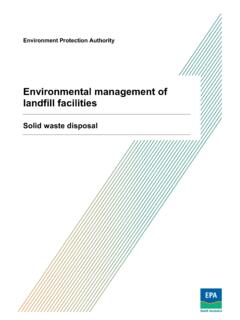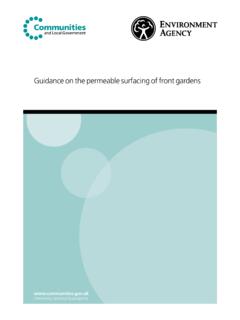Transcription of Planning policy for traveller sites - GOV.UK
1 August 2015 Department for Communities and Local Government Planning policy for traveller sites Crown copyright, 2015 Copyright in the typographical arrangement rests with the Crown. You may re-use this information (not including logos) free of charge in any format or medium, under the terms of the Open Government Licence. To view this licence, or write to the Information policy Team, The National Archives, Kew, London TW9 4DU, or email: This document/publication is also available on our website at If you have any enquiries regarding this document/publication, complete the form at or write to us at: Department for Communities and Local Government Fry Building 2 Marsham Street London SW1P 4DF Telephone: 030 3444 0000 For all our latest news and updates follow us on Twitter: August 2015 ISBN: 978-1-4098- 4670-3 Contents Introduction 1 Using evidence 2 policy A: Using evidence to plan positively and manage development 2 Plan-making 3 policy B: Planning for traveller sites 3 policy C: sites in rural areas and the countryside 4 policy D: Rural exception sites 5 policy E: traveller sites in Green Belt 5 policy F: Mixed Planning use traveller sites 5 policy G: Major development projects 6 Decision-taking 6 policy H: Determining Planning applications for traveller sites 6 policy I.
2 Implementation 8 Annex 1: Glossary 9 1 Introduction 1. This document sets out the Government s Planning policy for traveller1 sites . It should be read in conjunction with the National Planning policy Framework. Guidance on the Framework can be found at: 2. Planning law requires that applications for Planning permission must be determined in accordance with the development plan, unless material considerations indicate otherwise. This policy must be taken into account in the preparation of development plans, and is a material consideration in Planning decisions. 2 Local Planning authorities preparing plans for and taking decisions on traveller sites should also have regard to the policies in the National Planning policy Framework so far as relevant. 3. The Government s overarching aim is to ensure fair and equal treatment for travellers, in a way that facilitates the traditional and nomadic way of life of travellers while respecting the interests of the settled community.
3 4. To help achieve this, Government s aims in respect of traveller sites are: a. that local Planning authorities should make their own assessment of need for the purposes of Planning b. to ensure that local Planning authorities, working collaboratively, develop fair and effective strategies to meet need through the identification of land for sites c. to encourage local Planning authorities to plan for sites over a reasonable timescale d. that plan-making and decision-taking should protect Green Belt from inappropriate development e. to promote more private traveller site provision while recognising that there will always be those travellers who cannot provide their own sites f. that plan-making and decision-taking should aim to reduce the number of unauthorised developments and encampments and make enforcement more effective g. for local Planning authorities to ensure that their Local Plan includes fair, realistic and inclusive policies 1 See Annex 1 for the definition of traveller for the purposes of this statement.
4 2 Sections 19(2)(a) and 38(6) of the Planning and Compulsory Purchase Act 2004 and section 70(2) of the Town and Country Planning Act 1990. In relation to neighbourhood plans, under section 38B and C and paragraph 8(2) of new Schedule 4B to the 2004 Act (inserted by the Localism Act 2011 section 116 and Schedules 9 and 10) the independent examiner will consider whether having regard to national policy is appropriate to make the plan. 2 h. to increase the number of traveller sites in appropriate locations with Planning permission, to address under provision and maintain an appropriate level of supply i. to reduce tensions between settled and traveller communities in plan-making and Planning decisions j. to enable provision of suitable accommodation from which travellers can access education, health, welfare and employment infrastructure k. for local Planning authorities to have due regard to the protection of local amenity and local environment 5. To benefit those engaged in Planning for traveller sites , specific Planning policies for traveller sites are clearly set out in this separate document.
5 The Government intends to review this policy when fair and representative practical results of its implementation are clear. 6. The Government still intends to review in the future whether Planning policy for traveller sites should be incorporated within the wider National Planning policy Framework. This will be considered as part of any wider review of the Framework. Using evidence policy A: Using evidence to plan positively and manage development 7. In assembling the evidence base necessary to support their Planning approach, local Planning authorities should: a) pay particular attention to early and effective community engagement with both settled and traveller communities (including discussing travellers accommodation needs with travellers themselves, their representative bodies and local support groups) b) cooperate with travellers, their representative bodies and local support groups; other local authorities and relevant interest groups to prepare and maintain an up-to-date understanding of the likely permanent and transit accommodation needs of their areas over the lifespan of their development plan, working collaboratively with neighbouring local Planning authorities c) use a robust evidence base to establish accommodation needs to inform the preparation of local plans and make Planning decisions.
6 3 Plan-making policy B: Planning for traveller sites 8. Local Plans must be prepared with the objective of contributing to the achievement of sustainable development. To this end, they should be consistent with the policies in the National Planning policy Framework, including the presumption in favour of sustainable development and the application of specific policies in the Framework, and this Planning policy for traveller sites . 9. Local Planning authorities should set pitch targets for gypsies and travellers as defined in Annex 1 and plot targets for travelling showpeople as defined in Annex 1 which address the likely permanent and transit site accommodation needs of travellers in their area, working collaboratively with neighbouring local Planning 10. Local Planning authorities should, in producing their Local Plan: a) identify and update annually, a supply of specific deliverable sites sufficient to provide 5 years worth of sites against their locally set targets 4 b) identify a supply of specific, developable sites , or broad locations for growth, for years 6 to 10 and, where possible, for years 11-15 5 c) consider production of joint development plans that set targets on a cross-authority basis, to provide more flexibility in identifying sites , particularly if a local Planning authority has special or strict Planning constraints across its area (local Planning authorities have a duty to cooperate on Planning issues that cross administrative boundaries) d) relate the number of pitches or plots to the circumstances of the specific size and location of the site and the surrounding population s size and density e) protect local amenity and environment.
7 3 See Annex 1 for definitions of pitch and plot . 4 To be considered deliverable, sites should be available now, offer a suitable location for development, and be achievable with a realistic prospect that development will be delivered on the site within five years. sites with Planning permission should be considered deliverable until permission expires, unless there is clear evidence that schemes will not be implemented within 5 years, for example they will not be viable, there is no longer a demand for the type of units or sites have long term phasing plans. 5 To be considered developable, sites should be in a suitable location for traveller site development and there should be a reasonable prospect that the site is available and could be viably developed at the point envisaged 4 11. Criteria should be set to guide land supply allocations where there is identified need. Where there is no identified need, criteria-based policies should be included to provide a basis for decisions in case applications nevertheless come forward.
8 Criteria based policies should be fair and should facilitate the traditional and nomadic life of travellers while respecting the interests of the settled community. 12. In exceptional cases, where a local Planning authority is burdened by a large-scale unauthorised site that has significantly increased their need, and their area is subject to strict and special Planning constraints, then there is no assumption that the local Planning authority is required to plan to meet their traveller site needs in full. 13. Local Planning authorities should ensure that traveller sites are sustainable economically, socially and environmentally. Local Planning authorities should, therefore, ensure that their policies: a) promote peaceful and integrated co-existence between the site and the local community b) promote, in collaboration with commissioners of health services, access to appropriate health services c) ensure that children can attend school on a regular basis d) provide a settled base that reduces both the need for long-distance travelling and possible environmental damage caused by unauthorised encampment e) provide for proper consideration of the effect of local environmental quality (such as noise and air quality) on the health and well-being of any travellers that may locate there or on others as a result of new development f) avoid placing undue pressure on local infrastructure and services g) do not locate sites in areas at high risk of flooding, including functional floodplains, given the particular vulnerability of caravans h)
9 Reflect the extent to which traditional lifestyles (whereby some travellers live and work from the same location thereby omitting many travel to work journeys) can contribute to sustainability. policy C: sites in rural areas and the countryside 14. When assessing the suitability of sites in rural or semi-rural settings, local Planning authorities should ensure that the scale of such sites does not dominate the nearest settled community. 5 policy D: Rural exception sites 15. If there is a lack of affordable land to meet local traveller needs, local Planning authorities in rural areas, where viable and practical, should consider allocating and releasing sites solely for affordable traveller sites . This may include using a rural exception site policy for traveller sites that should also be used to manage applications. A rural exception site policy enables small sites to be used, specifically for affordable traveller sites , in small rural communities, that would not normally be used for traveller Rural exception sites should only be used for affordable traveller sites in perpetuity.
10 A rural exception site policy should seek to address the needs of the local community by accommodating households who are either current residents or have an existing family or employment connection, whilst also ensuring that rural areas continue to develop as sustainable , mixed, inclusive communities policy E: traveller sites in Green Belt 16. Inappropriate development is harmful to the Green Belt and should not be approved, except in very special circumstances. traveller sites (temporary or permanent) in the Green Belt are inappropriate development. Subject to the best interests of the child, personal circumstances and unmet need are unlikely to clearly outweigh harm to the Green Belt and any other harm so as to establish very special circumstances. 17. Green Belt boundaries should be altered only in exceptional circumstances. If a local Planning authority wishes to make an exceptional, limited alteration to the defined Green Belt boundary (which might be to accommodate a site inset within the Green Belt) to meet a specific, identified need for a traveller site , it should do so only through the plan- making process and not in response to a Planning application.















